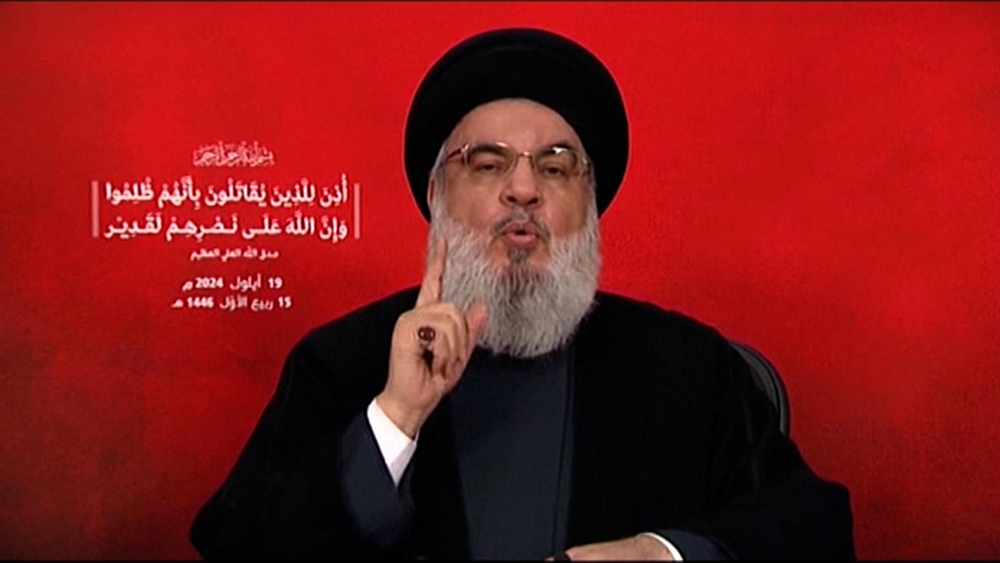|
Getting your Trinity Audio player ready...
|
(Israel Hayom) “We have three objectives: returning the hostages, dismantling Hamas and safely bringing back the residents of the north. These three remain our focus, despite the current media attention on the northern front,” said Brig. Gen. Amichai Levin, commander of Hatzerim Air Force Base, in a joint interview with Lt. Col. M., commander of the 69th Squadron, following the assassination of Hezbollah Secretary-General Hassan Nasrallah on Friday.
“The base, the squadron, and the entire IAF continue to operate intensively and significantly in Gaza, but we’ve reached a strategic point where it became necessary to separate the northern front from the Gaza arena to achieve all our objectives,” said Levin on Saturday. “If we want to return residents to the northern border, the separation between the fronts is critical, to dismantle Hamas and create conditions for the return of the hostages,” he added.
“Yesterday, we carried out a historic operation with deep strategic importance that extends beyond Lebanon’s borders. Nasrallah’s elimination will have a profound impact that will change the Middle East and bring us closer to achieving our war objectives. It was a very complex operation planned for a long time,” said Levin.
He described the operation as an example of “exceptional cooperation” between the Israel Defense Forces’ Military Intelligence Directorate and the air force. “Intelligence and the air force bring unimaginable capabilities to the table,” he said.
“Beyond the technical aspect, the operation expresses initiative, audacity, determination and offensiveness that were lacking before Oct. 7, and this is our most important lesson from it. We need to act proactively and offensively against all those who wish us harm—and there’s no shortage of them,” he said.
Lt. Col. M, 37, has been commanding the 69th “Hammers” Squadron, which carried out the Nasrallah strike, for several months. He took command in the middle of the war, having previously commanded an F-15 squadron at Tel Nof Base. M’s family is from the north, and his wife is originally from a kibbutz on the border with Lebanon. Her family on the kibbutz has been evacuated.
“The squadron has been operating on a war footing for about a year now, in all sectors, and in the last week has been attacking and defending significantly in the northern arena,” he said.
“The formation that flew on the Nasrallah mission was diverse, youth mixed with experience. I and a reservist led the operation. Everything [went according to plan], without hitches—not in the intelligence planning aspect, not in the planes, and not in the execution itself,” he said.
“We went out to attack massively, in the heart of Beirut, in Dahiya; we knew who we were going to eliminate,” he added.
“Three hugs after the landings: When we land, you hug the aircrews because you realize you’ve done something big, historic—once in a lifetime. The second hug was for my technical officer, who with his people armed the planes. He’s from the north, his uncle was killed by Hezbollah in 2007. And the third hug was for my wife when I returned home,” he said.
“Then we went straight back to work to carry out operational missions, without stopping, and mainly to wait. Just as there was quality intelligence pre-operation, to wait to confirm that the mission was completed,” he explained.
“The main operational challenge in this kind of operation is first and foremost accurate intelligence,” added Levin. “The second big challenge is to ensure that the object that needs to be eliminated, in this case Hassan Nasrallah, and others, don’t receive early warning and escape when the planes are on their way,” he added.
“We continue to refine this all the time, mainly through many young officers who come up with ideas on how to deceive our enemies so that the target remains stable during execution. The anti-aircraft array in Lebanon is very significant, and it’s still a threat,” he noted.
Despite this, however, “No missiles were fired at the planes during the execution, there was no risk to the planes in real time,” he said.
“To maintain security in case the operation is postponed—we work on the planning without knowing what the target is, we work on the conditions for the mission, and a few hours before execution, when we have approval, we reveal the operational details to the crews,” M explained.
“To achieve results, you need extraordinary intelligence, and you need to give credit to the entire intelligence community,” said Levin. “In addition, to bring [to bear] such an amount of heavy munitions […] with high synchronization, without malfunctions is a badge of honor for the technical array of the air force,” he added.
In response to a question about the protests against the government in 2023, led in some instances by 69th Squadron personnel, Levin responded, “69th Squadron is a strategic part of the IAF. Some of the most important missions that the IAF carries out are placed on its shoulders.
“The warriors in the squadron are diverse, half of them are reservists. Half of the participants in the latest operation are reserve fighters.
“Let none doubt their love for the State of Israel and their willingness to sacrifice their lives in missions near or far. This operation highlights this, but for 11 months already they have been flying around the clock in the squadron and will continue to do so for years to come.”
Originally published by Israel Hayom.
Sign up for Melanie Phillips’s Substack: CLICK HERE





